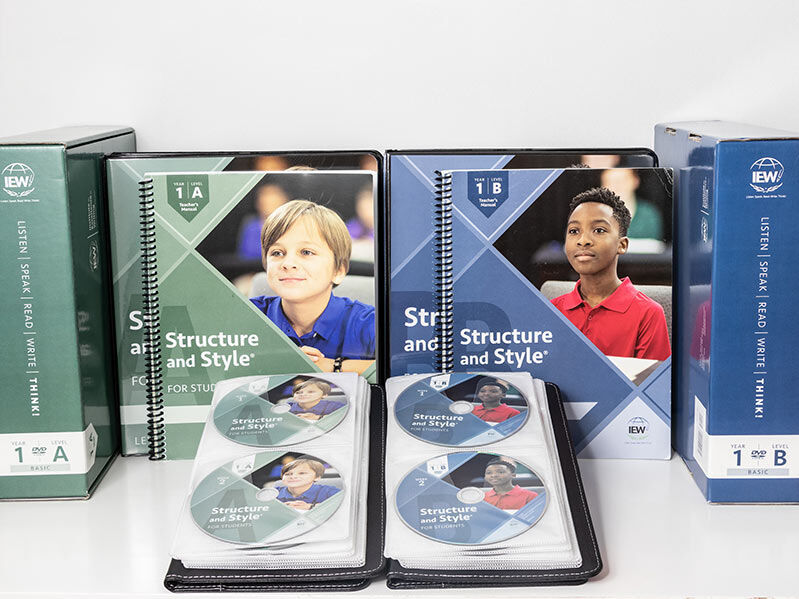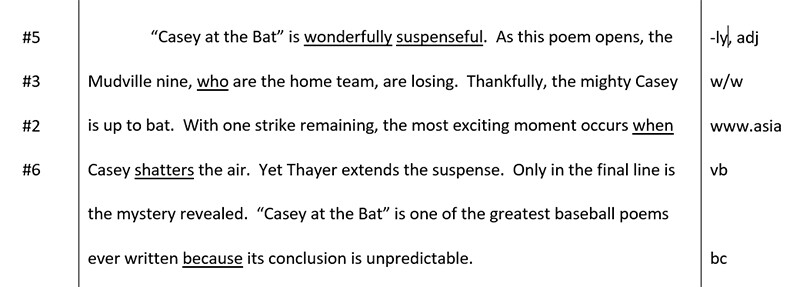Structure and Style for Students is a video-based writing curriculum with twenty-four lessons per level. Though introduced in 2020, it uses the same tried and true writing instruction the Institute for Excellence in Writing (IEW) has always championed. The underlying principles remain the same, but the new format makes IEW even more accessible to homeschool families.
With Structure and Style for Students, my children receive video instruction from Mr. Andrew Pudewa two days each week. They then complete their assignments before moving on to the next lesson. I get to step back from the teaching role and instead become their editor and course facilitator.
Table of Contents[Hide][Show]

Some of the links in this post are affiliate links. If you click through and make a purchase, I will earn a commission, but that commission will not increase the price you pay. As an Amazon Associate, I earn from qualifying purchases. Please read my disclosure policy to learn more.
IEW’s Methodology: Structure and Style
IEW uses an incremental approach to teach writing. First, students learn how to make outlines from existing content. Then they rewrite that content in their own words with the outline as a guide. Over time IEW introduces new structural models, but the student continues to write from sources in either written or picture form.
The inventive or creative writing that so often permeates other curricula doesn’t appear until Unit 7. IEW’s delay in teaching inventive writing is by design. Previous units prepare the student for this leap from source content to writing from the brain.
Watch as Mr. Pudewa explains the structure and style method.
The Structure
All writing assignments in IEW follow the structural models introduced in each unit. There are nine units in all. IEW teaches these units across levels which reinforces the concepts year after year.
- Unit 1: Note Making and Outlines
- Unit 2: Writing from Notes
- Unit 3: Retelling Narrative Stories (Story Sequence Chart)
- Unit 4: Summarizing a Reference
- Unit 5: Writing from Pictures
- Unit 6: Summarizing Multiple References
- Unit 7: Inventive Writing
- Unit 8: Formal Essay Models (Basic, Persuasive, Super)
- Unit 9: Formal Critique (replaces the traditional book report)
The Style
Of equal importance to the structural models are the stylistic techniques. IEW begins by teaching students to add dress-ups to their writing. As each dress-up is mastered, another is added. IEW then forces sentence variety by requiring students to begin using multiple sentence openers. Later levels and lessons require that students use decorations and advanced stylistic techniques in their writing.
The image below demonstrates the stylistic techniques required in the Unit 9 critique of “Casey at the Bat” from Structure and Style for Students Year 1 Level B. This was my sixth grader’s first formal critique.

He struggled with the underlying structure of the concluding paragraph as well as fitting in the required sentence openers. As his editor and course facilitator, I struggled with knowing how much help and guidance to provide. Since he will repeat Unit 9 in future years, those struggles should lessen with additional guidance and practice.
Dress-Ups
IEW generally begins with adding in the -ly adverb dress-up first. It then introduces and adds the remaining dress-ups incrementally in later lessons. Students underline their dress-ups and identify them in the right-hand margin as shown above.
- -ly adverb: “Casey at the Bat” is wonderfully suspenseful.
- who/which clause: … the Mudville nine, who are the home team, are losing.
- strong verb: … Casey shatters the air.
- because clause: … because its conclusion is unpredictable.
- quality adjective: “Casey at the Bat” is wonderfully suspenseful.
- www.asia clause (when, while, where, as, since, if, although): … the most exciting moment occurs when Casey shatters the air.
Sentence Openers
Over time, IEW requires students to use more sentence openers. This adds much-needed variety to their writing. The “Casey at the Bat” critique above includes four of these openers.
- #1 Subject: The subject or main clause opener is used frequently enough that this has not been a requirement in our IEW lessons thus far.
- #2 Prepositional: With one strike remaining, the most exciting…
- #3 -ly Adverb: Thankfully, the mighty Casey is up to bat.
- #4 -ing Opener: Although the #4 opener was not required in Structure and Style for Students Year 1 Level B, my son did learn to identify this sentence opener in Fix It! Grammar.
- #5 clausal opener (www.asia.b): As this poem opens, the Mudville nine…
- #6 VSS (very short sentence): Yet Thayer extends the suspense.
Decorations and Advanced Stylistic Techniques
Beyond dress-ups and sentence openers, IEW helps students increase their quality of writing by incorporating decorations and other advanced stylistic techniques. These are presented in higher levels of Structure and Style for Students.
- Decorations include alliteration, questions, conversations and quotations, 3sss (three short staccato sentences), similes and metaphors, and the dramatic open-close.
- The advanced stylistic techniques are the triple extension and teeter totter, which our family has not yet encountered with Structure and Style for Students.
Banned Verbs and Adjectives
IEW also bans the use of some common verbs (e.g., see/saw, come/came, think/thought) and adjectives (e.g., good/bad). Just as with dress-ups and sentence openers, the banned words list grows over time. Banning these verbs and adjectives helps the student identify strong verbs and quality adjectives to use as replacements.
Since my daughter chose “amazingly” as her -ly adverb dress-up in most paragraphs, I soon added it to our list of banned words. Forcing variety in her adverbs definitely improved her writing.
The Checklist
One of my favorite features of IEW is the checklist because it provides an objective way to assess my children’s writing. The checklist also lets the student know the exact requirements for the assignment. In our homeschool, writing assignments aren’t marked complete until every item on the checklist is fulfilled.
Each writing assignment has a unique checklist. The checklist is relatively short for the beginning lessons and grows quite substantially by the final lesson. You can always alter the checklist to fit your needs. If you child isn’t ready for the next dress-up or sentence opener, simply cross out that item on the checklist.


Helping Your Student
Knowing how much help to give your student is difficult. As my children’s editor, I often find myself wanting to lead them in a certain direction to make their writing sound better. The checklist keeps me grounded. If their writing correctly follows the structural model, includes the stylistic techniques, and makes sense, then I don’t need to improve upon it even if I’m tempted to do so.
With Structure and Style Year 1 Level B, my son began focusing on the stylistic techniques first. He would write his assignment to include these even if it didn’t make sense, stay on topic, or completely follow the structural model. As his editor I had to help him focus on his content first before going back and adding in the required stylistic techniques.
Read More: 4 Deadly Errors of Teaching Writing (particularly #2)
Components of Structure and Style for Students
Each level of Structure and Style for Students includes twenty-four video lessons, a student binder, a student packet with all handouts, and a teacher’s manual.
Try three free weeks of Structure and Style for Students.
Video Lessons
When ordering Structure and Style for Students, you have two options for the video lessons: forever streaming or DVDs. There are pros and cons of each format, so consider when and where your student will watch the videos as well as the strength and availability of your Internet connection.

The video-based lessons were filmed in a classroom setting over the course of two years. Mr. Pudewa is friendly and engaging with the students in his classroom. My children love his jokes and look forward to meeting him at our next homeschool convention.
Lesson Plans
The spiral-bound teacher’s manual includes images of every handout in the student pack. Each lesson begins with a section titled Teacher Preparation. This often refers to watching a portion of a video from Teaching Writing: Structure and Style (TWSS) to prepare for the next class. Since I was already familiar with IEW and had previously viewed several of the TWSS videos, I only needed to refer to TWSS when we began some of the later units that we had not previously covered.
Read More: Do I Really Need Teaching Writing: Structure and Style?
The lesson plans also include the board notes. I didn’t have time to watch every Structure and Style for Students video with my children last year. Yet I could compare my children’s notes with the board notes to make sure that they hadn’t missed anything important.
Each lesson plan ends with the tips for keeping the student binder organized as well as the homework assignments.
Schedule and Pace
IEW set an ambitious schedule of twenty-four weeks for Structure and Style for Students. They realize this and offer a suggested thirty-week schedule as well.
In our homeschool, we moved at our own pace. Most of the lessons, especially those at the beginning, could be completed in one week. However, as we moved into units six, eight, and nine, we usually took at least two weeks to complete a lesson. Since there are only twenty-four lessons, we still had enough buffer in our schedule to complete IEW when other parts of our curriculum wrapped up as well.

Visit my IEW affiliate page to find the latest information on special events, my favorite products and audio talks, and more helpful information from IEW. You’ll want to use the link at the very bottom to sign up for IEW’s newsletter.
Other Writing Resources from IEW
The easiest way to navigate through IEW’s many resources is to request their Magalog (Magazine and Catalog). It is available in both print and digital format.
To learn more about IEW including the 100% satisfaction guarantee and yearly promotions, read IEW: A Language Arts Asset for Homeschools (& Traditional Schools).
Theme-Based Writing Lessons

In addition to the video-based Structure and Style for Students, IEW has numerous theme-based writing lessons.
We have the following theme-based writing lessons.
- Bible Heroes – This is a great introduction to writing for young students. My children have used this resource in the second grade.
- Fables, Myths, and Fairy Tales – This is one of the easier theme books for Level A. It may be too easy after completing a Level A Structure and Style for Students course.
- Wonders of Science
- Following Narnia® Volume 1: The Lion’s Song
- Bible-Based Writing Lessons – My eighth grader completed this book for the 2022-23 school year. His writing and endurance improved a lot with this theme book. The last lessons had me referring back to our Teaching Writing Structure and Style DVDs for more support.
Note that IEW always indicates which resources contain distinctly Christian content such as the Bible Heroes and Narnia theme books. Most of their resources including Structure and Style for Students are secular-friendly.
Teaching Writing: Structure and Style

Teaching Writing: Structure and Style (TWSS) is a flagship product from IEW. This program is for the teacher rather than the student. TWSS helps the teacher understand the entire structure and style methodology. Although it is possible to use Structure and Style for Students without TWSS, I have found it helpful to have both teaching tools to make the best use of the program.
Read More: Do I Really Need Teaching Writing: Structure and Style?
Fix It! Grammar

The lessons in Structure and Style for Students align well with the Fix It! Grammar series. Both resources include six levels, and Structure and Style for Students schedules Fix It! Grammar as an optional resource.
Related: Fix It! Grammar {Review}
Try a sample of Fix It! Grammar.
Conclusion
I feel fortunate to have had veteran homeschoolers recommend IEW to our family in the early years. We’ve been so pleased with the program that we’ve never looked elsewhere for writing and grammar instruction. IEW gives me the confidence and tools that I need to teach my children to write well.
